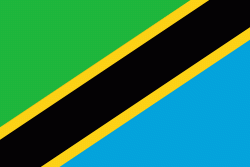Katavi Region (Katavi Region)
Katavi Region (Mkoa wa Katavi in Swahili) is one of Tanzania's 31 administrative regions. The region covers an area of 45,843 km2. The region is comparable in size to the combined land area of the nation state of Estonia. Kagera Region is bordered to the east by Tabora Region. The region is bordered to the south by Rukwa Region and Songwe Region. Lastly, Katavi borders DRC on Lake Tanganyika to the west. The region derives its name from Katavi, the spirit of lake Tanganyika. The regional capital city is Mpanda. According to the 2012 national census, the region had a population of 564,604.
The Katavi region is located between Longitude 30° and 33° East of Greenwich and Latitudes 5° 15° to 7° 03° South of the Equator. It is bordered to the north by the Urambo District (Tabora), to the east by the Sikonge District (Tabora), to the east by the Chunya District (Mbeya), to the south by the Sumbawanga District (Rukwa), to the south-east by the Democratic Republic of the Congo (separated by Lake Tanganyika), and to the northwest by the Kigoma District (Kigoma).
At an altitude of 1,000 to 2,500 meters above sea level, the Katavi Region has typical yearly temperatures between 26 and 30 degrees celsius. The range of the average annual rainfall is 920 to 1,200 mm. The district is made up of gentle plains, plateaus, tiny mountain peaks, moderate hills, and Mwese highlands. The soft plains of the Karema depression, the Katumba plains, and Lake Tanganyika, which has steep hills, mild plateaus, and plains, are other features that define the area. The region's miombo forests are covered in the most greenery.
The Katavi region is located between Longitude 30° and 33° East of Greenwich and Latitudes 5° 15° to 7° 03° South of the Equator. It is bordered to the north by the Urambo District (Tabora), to the east by the Sikonge District (Tabora), to the east by the Chunya District (Mbeya), to the south by the Sumbawanga District (Rukwa), to the south-east by the Democratic Republic of the Congo (separated by Lake Tanganyika), and to the northwest by the Kigoma District (Kigoma).
At an altitude of 1,000 to 2,500 meters above sea level, the Katavi Region has typical yearly temperatures between 26 and 30 degrees celsius. The range of the average annual rainfall is 920 to 1,200 mm. The district is made up of gentle plains, plateaus, tiny mountain peaks, moderate hills, and Mwese highlands. The soft plains of the Karema depression, the Katumba plains, and Lake Tanganyika, which has steep hills, mild plateaus, and plains, are other features that define the area. The region's miombo forests are covered in the most greenery.
Map - Katavi Region (Katavi Region)
Map
Country - Tanzania
 |
 |
| Flag of Tanzania | |
Many important hominid fossils have been found in Tanzania, such as 6-million-year-old Pliocene hominid fossils. The genus Australopithecus ranged across Africa between 4 and 2 million years ago, and the oldest remains of the genus Homo are found near Lake Olduvai. Following the rise of Homo erectus 1.8 million years ago, humanity spread all over the Old World, and later in the New World and Australia under the species Homo sapiens. H. sapiens also overtook Africa and absorbed the older species of humanity. Later in the Stone and Bronze Age, prehistoric migrations into Tanzania included Southern Cushitic speakers who moved south from present-day Ethiopia; Eastern Cushitic people who moved into Tanzania from north of Lake Turkana about 2,000 and 4,000 years ago; and the Southern Nilotes, including the Datoog, who originated from the present-day South Sudan–Ethiopia border region between 2,900 and 2,400 years ago. These movements took place at about the same time as the settlement of the Mashariki Bantu from West Africa in the Lake Victoria and Lake Tanganyika areas. They subsequently migrated across the rest of Tanzania between 2,300 and 1,700 years ago.
Currency / Language
| ISO | Currency | Symbol | Significant figures |
|---|---|---|---|
| TZS | Tanzanian shilling | Sh | 2 |
| ISO | Language |
|---|---|
| AR | Arabic language |
| EN | English language |















